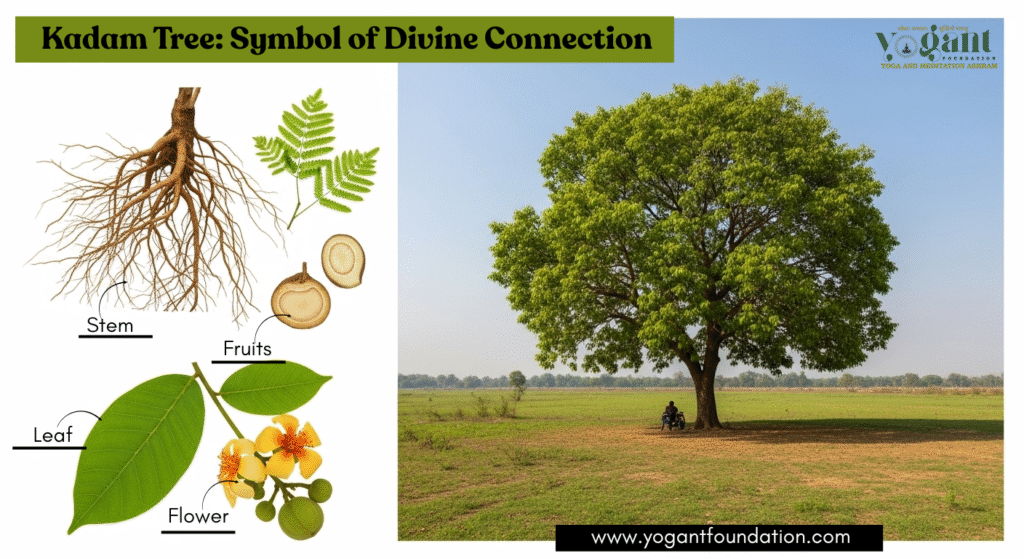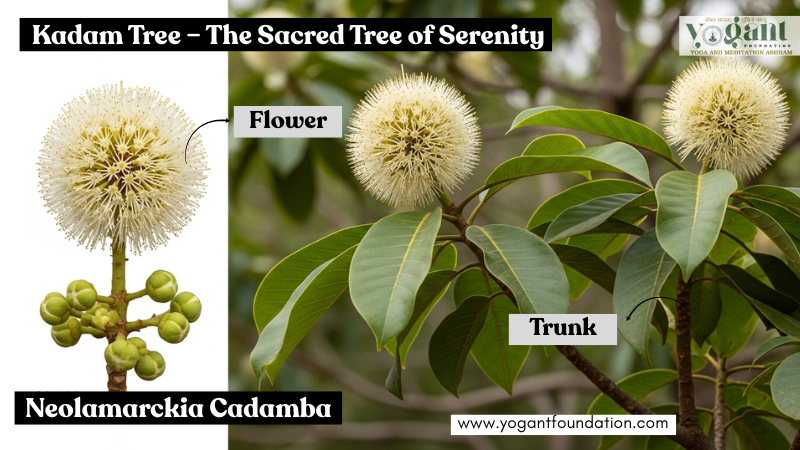Introduction: What is the Kadam Tree?
The Kadam Tree, also called Neolamarckia Cadamba, is one of the most popular trees in India. Kadam tree revered by Indians for its bright yellow, round flowers.
You probably saw this lovely Tree blossoming in the monsoons, spreading its aroma throughout villages and temple grounds. Kadamba trees are beautiful and have many benefits. They provide shade as well as medicinal properties, environmental benefits, and spiritual symbolism.
The Kadamba Tree is the subject of this blog. From its scientific description to its mythological and traditional medical uses, you’ll learn everything there is about it.
Scientific Classification of Kadamba Tree
| Scientific Name | Neolamarckia cadamba |
| Family | Rubiaceae |
| Common Names | Kadamba, Kadam, Kadamba Tree |
| Native Region | India Southeast Asia |
| Type | Evergreen Tropical Tree |
| Floral Season | Monsoons (June-September) |
Spiritual and Mythological Significance of the Kadamba Tree
In Indian mythology, the Kadam tree considered sacred, and it has a deep association with Krishna. Legends claim that Krishna played his flute underneath in Vrindavan. There, he also performed his Ras Leela together with the Gopis.
The round, golden flowers are a symbol of unity and wholeness. Kadam flowers can be found in many temples, particularly those of Uttar Pradesh, Bengal, and Odisha.
Buddha worships the Tree for its symbolism of peace and enlightenment. It are mentioned by Buddhist texts in several places as being a place for meditation and realizing oneself.
The flute of Lord Krishna was played under the Kadam tree, awakening all the beings.
Physical Description: The Beauty of the Kadam Tree
The Kadamba Tree has an evergreen canopy that can reach 45 meters in height. The Tree’s strong and straight trunk offers deep shade and is ideal for landscaping along gardens or roadsides.
Flowers have a golden yellow color and are spherical. They look like small suns on branches. Their fragrant attracted bees as well as butterflies and birds.
Its foliage is large and glossy. This contributes to purifying and cooling the surrounding air. Its blossoms transform the landscape and remind people of monsoon calmness.
Kadam Tree in Ayurveda and Traditional Medicine
According to Ayurveda, the Kadamba tree’s bark, leaves, flowers, and fruit all have medical value. Discover how the sacred plant can contribute to your health and wellbeing.

Kadam Tree Medicinal Uses :
- Bark: It is used to treat skin conditions, fever, and inflammation. It contains antibacterial and anstringent properties.
- Leaves: Crushed sage leaves used as a natural remedy for headaches, wounds, and ulcers. The paste offers cooling effects.
- Kadam flowers: Kadams used as part of Aromatherapy in order to alleviate stress. Also, they help to relieve nausea and respiratory irritation.
- Fruits: A fruit’s pulp can act as a natural detoxifier to improve digestion and liver function.
- Roots: In herbal decoctions, roots like Kadam are often used to treat pain and fever.
In Ayurvedic Terms:
- Rasa (Taste): Bitter, Astringent
- Guna (Quality): Light, Dry
- Virya (Potency): Cooling
- Dosha effects: Balancing Pitta and Kapha doshas.
Ayurvedic physicians often refer to the Kadam as “Nature’s Pharmacy” because it has powerful healing properties.
Environmental and Ecological Importance of the Kadam Tree
This is much more than a religious symbol. This is an act that protects the environment. Here’s why:
Ecological Benefits:
- Environmental Benefits: This tree thrives in climates with a lot of rainfall.
- Kadamba Tree: Purifies the air by releasing and absorbing CO2.
- Shade Provider: This dense canopy tree can provide shade in tropical climates.
- Rainwater Management: Trees are a great way to manage rainfall by increasing the groundwater level and preventing soil erosion.
- Support for Wildlife: Flower and Fruit are good for wildlife: They attract birds, other animals, and help maintain the ecological balance.
Many environmental groups have promoted this tree as an excellent choice for planting in urban areas because it grows quickly and requires little maintenance. They also increase biodiversity.
Kadam Tree in Culture, Festivals, and Literature
It has mentioned in many ancient poems and songs. Its symbolic meaning is linked with love, devotion, and nature’s rhythm.
Planted by devotees around Krishna’s temples in Vrindavan to symbolize divine love. Kadams flowers are commonly used people in Assam as well as Bengal for monsoon celebrations like Rath Yatra.
In literature, the Kadamba Tree has referred to as symbolizing monsoon happiness and divine connection. Kalidasa referred to its golden blossoms when describing Indian nature.
How to Grow and Care for a Kadam Tree
Growing a Kadamba Tree is an easy and rewarding process. The following tips will help you grow the Tree successfully, whether or not you are a gardening enthusiast.
Grow a Kadam Tree in Steps:
- Environment: The Tree thrives in tropical climates where there is plenty of rainfall.
- Soils: Well-drained, loamy soil rich in organic material
- Water: it regularly for the first two to three years. You only need to pay minimal attention after that.
- Germination : Growing from seedlings and saplings. The seeds are best planted in moist soil during the early monsoon.
- Maintenance:
- Trim the old branches each year.
- Compost organically to enhance growth.
- Protect your home from termites and fungi.
In 3-4 years, the Kadamba tree starts to bloom, filling up your garden and home with a divine aroma.
Kadam Tree and Its Symbolism in Modern Times
The Kadam Tree is a symbol of eco-consciousness and a green revival. Urban planners and eco volunteers plant this Tree in parks, schools, and temple grounds.
The bridge is also symbol of harmony between humans and nature.
The Kadamba tree is a symbol of Mother Earth’s spirituality.
Fun Facts
- Kadam Trees live over 100 years.
- It is in full bloom from September to June.
- Kadam flowers have a small ball shape and are commonly used in perfumes.
- The Sanskrit term Kadamba means “fragrance”.
- This tree is usually planted as a sacred one near Hindu temples, ashrams.
Importance of the Kadam Tree in Yoga and Meditation
Kadam Trees are commonly found at Ashrams, Yoga Retreats, especially in Rishikesh or Vrindavan. Meditation is done under it due to its soothing energy and oxygen-rich shade.
You can:
- It is possible to deepen meditation.
- Purifying the Air Around Yoga Spaces
- Connection of practitioners with Earth’s energy
Meditating beneath the Kadam Tree also provides peace and clarity. It also gives a strong sense of protection.
Uses in Everyday Life
| Part Used | Uses |
| Leaves | Use herbal poultice on wounds |
| Flowers | Fragrance and relaxation, rituals of religious worship |
| Bark | Ayurvedic dyes and medicine |
| Wood | Furniture and paper made of lightweight materials |
| Roots | Decoctions for pain and fever relief |
Conservation and Protection
Deforestation and Urbanization are responsible for the decline of Kadam Trees. Conservationists want people to do the following:
- Include Kadam Trees in urban greening projects
- Educate children about native flora
- Kadam Trees can help you celebrate World Environment Day
It is a small step that can preserve biodiversity as well.
The Kadam Tree in Global Perspective
Kadam trees are also native to Thailand, Sri Lanka, Malaysia & Indonesia. In Southeast Asia, the Kadam Tree is prized for its timber and medical uses. While in India, it holds spiritual importance.
Kadam Tree is truly a global symbol of harmony, because it combines practical and spiritual advantages.
Conclusion: A Symbol of Divine Connection and Natural Balance
The Kadam Tree is a tall, imposing reminder of the deep connection between nature and spirituality. It continues to provide shade, scent, and healing to the Earth from the days of Lord Krishna up to the modern city of India.
The Kadam Tree is a symbol of the cycle that our ancient ancestors cherished. It represents love, balance, and life.
Under the shade of Kadam Trees, you will find not only coolness in the air but also peace of mind. “



